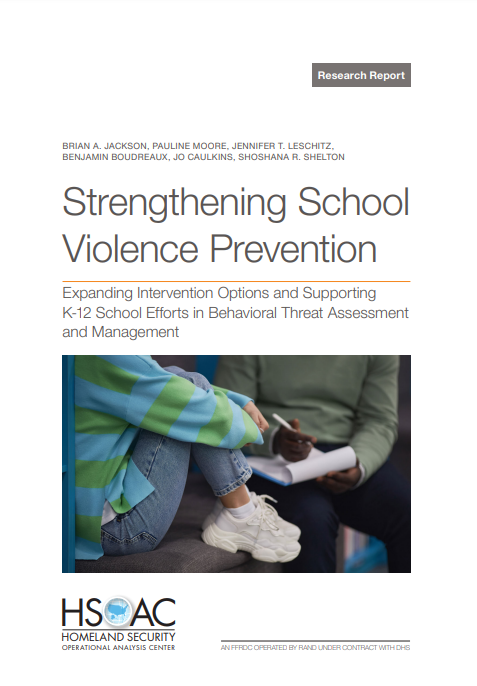목차
About This Report iii
Summary v
Summary v
CHAPTER 1
Introduction 1
Behavioral Threat Assessment and Management 1
Approach and Organization of This Report 6
CHAPTER 2
Current Approaches to Behavioral Threat Management in the K–12 School Environment 13
Multidisciplinary BTAM Teams in K–12 Schools 13
Matching Interventions and Supports to Individual Cases 18
Following Up on Behavioral Threat Management Plans 28
Conclusions and Implications from Stakeholder Interviews 32
CHAPTER 3
Intervention Options for Behavioral Threat Management 35
Characterizing the Full Range of Intervention Options for Behavioral Threat Management 37
Resources on the Effectiveness of Behavioral Threat Management Options 46
Conclusions 47
CHAPTER 4
Strengthening the Matching of Interventions to Student Needs During the BTAM Process 49
Expert Judgment and Practitioner Expertise as the Starting Point for Intervention and Behavioral Threat Management 50
Other Disciplines with Needs Identification and Service-Matching Challenges Provide Useful Lessons for Developing BTAM Decision Aids or Tools 56
Expansion of Information-Gathering During Behavioral Threat Assessment Can Support Management 59
Behavioral Threat Management Does Not Stop Once the Initial InterventionPlan Is Implemented 60
Greater Focus on Monitoring Threat Management Effectiveness Could Benefit Both Students and School BTAM Programs 65
Conclusions and Implications 68
CHAPTER 5
Conclusions and Implications for the K–12 School Community 69
Managing and Guiding Student Behavior Is the Common Denominator Across School Behavior Management and Public Safety–Focused Interventions 69
Schools Can Expand Their Capability to Meet Student Needs by Building or Gaining Access to the Full Range of Management Options 71
Building Better Support for Selecting Management Options During Behavioral Threat Assessment Could Benefit BTAM Teams 72
BTAM Is a Process, Not an Event 75
Although Expert Judgment on a BTAM Team Will Always Be the Core of Building Interventions Plans, Decision Tools Can Help Support Experts 76
In Closing 77
APPENDIXES
A. Detailed Methods 79
B. Full Inventory of Intervention Options for Behavioral Threat Management 95
C. Review of Need-Intervention Matching Approaches from Multidisciplinary Fields 117
D. Questions to Guide Threat Management Planning to Address Individual Case and Student-Specific Needs 139
Abbreviations 143
References 145




